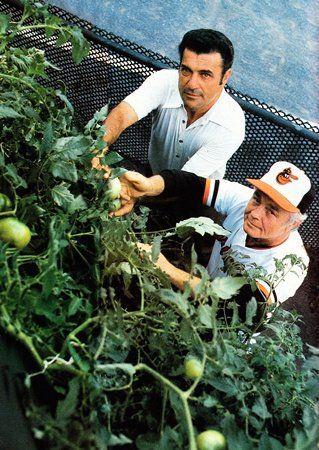 Earl Weaver and Pasquale “Pat” Santarone, tomato farmers extraordinaire at Memorial Stadium, would be happy to see the latest trend in Major League Baseball: urban farms and gardens within the ballpark walls.
Earl Weaver and Pasquale “Pat” Santarone, tomato farmers extraordinaire at Memorial Stadium, would be happy to see the latest trend in Major League Baseball: urban farms and gardens within the ballpark walls.
Actually, we’re not sure it’s a trend, as only five teams have installed urban farms and gardens at their ballparks. And it’s certainly not new: Weaver and Santarone grew tomatoes at Memorial Stadium for 17 seasons after the 1970 World Series win for the Baltimore Orioles, and Joe Pignatano spend years cultivating veggies in the Shea Stadium bullpen when he was a New York Mets coach, beginning in 1969.
But these efforts, as quirky as they were, did not result in anything for fans: they were simply were sidelines for players and coaches. Today’s ballpark gardens are designed to educate fans and to provide fresh produce for the concessionaires, albeit on a very limited basis: there’s no way a ballpark garden can come close to filling the daily needs of an Aramark or Levy Restaurants at an MLB facility. Still, there are some major efforts involved: while the San Diego Padres were pioneers of this movement in 2011, the Boston Red Sox and San Francisco Giants went all in with much larger gardens in 2014 and 2015, per Thinkprogress.org:
When it opened in June of 2014, the space — dubbed the Garden at AT&T Park — covered 4,320 square feet. In addition to produce, the Garden houses a bar, tables, benches, a fire pit, and two concession stands that serve food prominently featuring Garden-grown ingredients. Produce-wise, the Garden grows everything you’d expect to find in a backyard garden patch (lettuce, tomatoes, zucchini) and a few things you wouldn’t (passion fruit, lemongrass, hops). When it opened, Giants right fielder Hunter Pence — a self-proclaimed health nut — was on site to christen the Garden.
“If you want to inspire kids to eat healthy,” Pence said, “you have got to eat healthy yourself.”
And so the Garden at AT&T Park was the largest edible garden at a baseball stadium, until the next baseball season, when all 5,000 square feet of Fenway Farms took root in the Boston landmark….The Red Sox consulted with architects and structural engineers to make sure that the chosen section of roof support the weight of a farm, worked with a company that specializes in building green structures on rooftops, and brought in Green City Growers to plant, maintain, and harvest the crops.
Other ballparks to feature gardens include Coors Field and Nationals Park.
